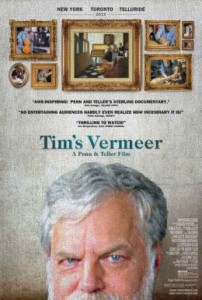“Despite his prolific output depicting the city, Turner made only three short visits, spending a total of less than three weeks in Venice.”
from Seven Days in the Art World by Sarah Thornton.

“Despite his prolific output depicting the city, Turner made only three short visits, spending a total of less than three weeks in Venice.”
from Seven Days in the Art World by Sarah Thornton.
 What if you could paint your own Vermeer? Teller (as in the famous magicians Penn and Teller) has directed a new documentary called Tim’s Vermeer. It was shown at the recent Telluride and Toronto Film Festivals and is receiving great reviews. It follows the investigation of an inventor, Tim Jenison, into the painting methods of Jan Vermeer. Jenison is best known to those in Digital Media as the founder of NewTek and the mastermind behind the revolutionary Video Toaster (along with Dana Carvey’s brother Brad) back in the 1980s.
What if you could paint your own Vermeer? Teller (as in the famous magicians Penn and Teller) has directed a new documentary called Tim’s Vermeer. It was shown at the recent Telluride and Toronto Film Festivals and is receiving great reviews. It follows the investigation of an inventor, Tim Jenison, into the painting methods of Jan Vermeer. Jenison is best known to those in Digital Media as the founder of NewTek and the mastermind behind the revolutionary Video Toaster (along with Dana Carvey’s brother Brad) back in the 1980s.
The ‘suffering artist‘ became a theme almost simultaneously with artists becoming famous in the Renaissance. Benvenuto Cellini’s 16th century autobiography contains in equal measures declarations of his achieving the impossible as an artist and collapses in his health when his work became “more than he could stand.” These would result in him throwing himself onto his supposed deathbed because of his trials and tribulations. One can only sympathize with his poor housekeeper who had to withstand his cries of “I shall not be alive tomorrow” and “I feel I am dying!” while he ordered her about.
In this month’s issue of the Atlantic, Olga Khazan discusses a new journal article by Julio Montes-Santiago, a doctor from Spain, in her article called “How Important Is Lead Poisoning to Becoming a Legendary Artist?” While I usually am suspicious of articles in non-art oriented journals that pretend to ‘discover’ why an artist painted a certain way, there is no question that lead is a poison. That’s why, even though it creates a warm, beautiful white, lead pigment is not used by commercial paint manufacturers anymore. Dr. Montes-Santiago traces the history of ‘painters madness’ and the many famous artists and composers who may have suffered from it. For example, he believes that one reason Michelangelo suffered from terrible kidney stones in his old age was his use of lead white paint.
Others have written of the impact the terrible illnesses that 19th century Romantic painter Francisco Goya suffered during his lifetime had on his career and the possibility that lead paint contributed to them (Goya was reputed to use enormous quantities of lead white in both his priming and paint). Goya’s near deafness came after a bout of illness in the 1790s and eventually forced him to leave his position as a teacher in the Academy (he couldn’t hear the students’ questions any longer). Ultimately, he left the Spanish court as well and and retreated to what he called his “Deaf Man’s House” in the countryside, where he painted the famous Black Paintings, like “Saturn Devouring his Son.” Saturnism, ironically, is another word for ‘lead poisoning.’
Khazan’s article in the Atlantic discusses other writings on the subject of lead poisoning from the past as well and is an interesting discussion of how health issues may have haunted our favorite artists. It’s well worth a look.